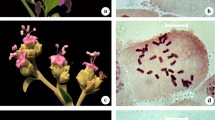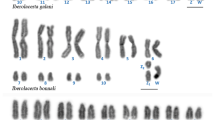Abstract
Standard and C-banded karyotypes of 101 specimens of the skink genus Lampropholis, including all but one of the 10 described species, were examined to assess the value of karyotypic data for resolving current systematic problems with Lampropholis. Diploid chromosome numbers were mostly 30 except for two forms with 28 chromosomes due to a reduction in the number of microchromosomes. The majority of interspecific chromosome changes were due to pericentric rearrangements. Apart from karyotypes referable to the described species, four distinct karyomorphs were found. Individuals possessing these karyomorphs could not be readily assigned to any of the described species.
Similar content being viewed by others
References
Bickham, J. W., 1983. Patterns and modes of chromosomal evolution in reptiles. In: A. K. Sharma and A. Sharma (eds), Chromosomes in evolution of eucaryotic groups. Vol. 2. CRC, Boca Rouge Florida: 13–40.
Cogger H. G., 1983. Reptiles and Amphibians of Australia. A. H. and A. W. Reed, Sydney.
Covacevich J., 1971. Amphibian and Reptile type-specimens in the Queensland Museum. Mem. Qd Mus. 16: 49–67.
Donnellan, S. C., 1991. Chromosomes of Australian Lygosomine Skinks (Lacertilia: Scincidae). I. The Egernia group. Genetica (in press).
Gorman G. C., 1973. The chromosomes of the Reptilia, a cytotaxonomic interpretation. In: A. B. Chiarelli and E. Capanna (eds), Cytotaxonomy and vertebrate evolution. Academic Press, New York: 349–424.
Gorman G. C., Atkins L. & Holzinger T., 1967. New karyotypic data on fifteen genera of lizards in the family Iguanidae with a discussion of taxonomic and cytological implications. Cytogenetics 6: 286–299.
Greer A. E., 1974. The generic relationships of the scincid lizard genus Leiolopisma and its relatives. Aust. J. Zool. Suppl. Ser. 31: 1–67.
Greer A. E. & Kluge A. G., 1980. A new species of Lampropholis (Lacertilia: Scincidae) from the rainforests of north-eastern Queensland. Occ. Pap. Mus. Zool. Uni. Michigan 691: 1–12.
Hardy G. S., 1979. The karyotypes of two scincid lizards, and their bearing on relationships in genus Leiolopisma and its relatives (Scincidae: Lygosominae). N. Z. J. Zool. 6: 609–612.
Ingram G. & Rawlinson P., 1981. Five new species of skinks (genus Lampropholis) from Queensland and New South Wales. Mem. Qld. Mus. 20: 311–317.
King M., 1973. Karyotypic studies of some Australian Scincidae (Reptilia). Aust. J. Zool. 21: 21–32.
King M., 1977. The evolution of sex chromosomes in lizards. In: J. H. Calaby and C. H. Tyndale-Biscoe (eds), Reproduction and evolution. Australian Academy of Science: Canberra: 55–60.
King M., 1982. Karyotypic evolution in Gehyra (Gekkonidae: Reptilia). II. A new species from Alligator Rivers region in Northern Australia. Aust. J. Zool. 30: 93–101.
King M., 1983a. Karyotypic evolution in Gehyra (Gekkonidae: Reptilia). III. The Gehyra australis complex. Aust. J. Zool. 31: 723–741.
King M., 1983b. The Gehyra australis species complex (Sauria: Gekkonidae). Amphibia-Reptilia 41: 147–169.
King M. & King D., 1975. Chromosomal evolution in the lizard genus Varanus (Reptilia). Aust. J. Biol. Sci. 28: 89–108.
Lande R., 1979. Effective deme sizes during long-term evolution estimated from rates of chromosomal rearrangement. Evolution 33: 234–251.
Mather P., 1990. Electrophoretic and morphological comparisons of Lampropholis delicata (Lacertilia: Scincidae) populations from Eastern Australia, and a resolution of the taxonomic status of this species. Aust. J. Zool. 37: 561–74.
Porter C. A. & Sites J. W., 1985. Normal disjunction in Robertsonian heterozygotes from a highly polymorphic lizard population. Cytogenetics and Cell Biology 39: 250–257.
Richardson B. J., Baverstock P. R. & Adams M., 1986. Allozyme Electrophoresis. Academic Press, Sydney.
Storr G. M., 1979. The Diplodactylus vittatus complex (Lacertilia, Gekkonidae) in Western Australia. Rec. west. Aust. Mus. 7: 391–402.
Sumner A. T., 1972. A simple technique for demonstrating centromeric heterochromatin. Exp. Cell Res. 75: 304–306.
Wright J. W., 1973. Evolution of the X/X2Y sex chromosome mechanism in the scincid lizard Scincella laterale (Say). Chromosoma 43: 101–108.
Author information
Authors and Affiliations
Rights and permissions
About this article
Cite this article
Donnellan, S.C. Chromosomes of Australian lygosomine skinks (Lacertilia: Scincidae). Genetica 83, 223–234 (1991). https://doi.org/10.1007/BF00126228
Received:
Accepted:
Issue Date:
DOI: https://doi.org/10.1007/BF00126228




